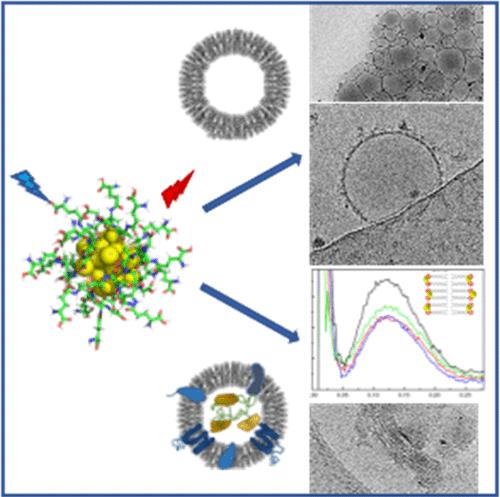当前位置:
X-MOL 学术
›
J. Phys. Chem. Lett.
›
论文详情
Our official English website, www.x-mol.net, welcomes your
feedback! (Note: you will need to create a separate account there.)
Luminescent Gold Nanoclusters Interacting with Synthetic and Biological Vesicles
The Journal of Physical Chemistry Letters ( IF 4.8 ) Pub Date : 2022-07-24 , DOI: 10.1021/acs.jpclett.2c01071 Regina M Chiechio 1, 2, 3 , Solène Ducarre 1 , Grégory Moulin 1, 4 , Aurélien Dupont 5 , Célia Marets 1 , Pascale Even-Hernandez 1 , Franck Artzner 6 , Paolo Musumeci 2 , Giorgia Franzò 3 , Célia Ravel 4, 7 , Maria José LoFaro 2, 3 , Valérie Marchi 1
The Journal of Physical Chemistry Letters ( IF 4.8 ) Pub Date : 2022-07-24 , DOI: 10.1021/acs.jpclett.2c01071 Regina M Chiechio 1, 2, 3 , Solène Ducarre 1 , Grégory Moulin 1, 4 , Aurélien Dupont 5 , Célia Marets 1 , Pascale Even-Hernandez 1 , Franck Artzner 6 , Paolo Musumeci 2 , Giorgia Franzò 3 , Célia Ravel 4, 7 , Maria José LoFaro 2, 3 , Valérie Marchi 1
Affiliation

|
According to their high electron density and ultrasmall size, gold nanoclusters (AuNCs) have unique luminescence and photoelectrochemical properties that make them very attractive for various biomedical fields. These applications require a clear understanding of their interaction with biological membranes. Here we demonstrate the ability of the AuNCs as markers for lipidic bilayer structures such as synthetic liposomes and biological extracellular vesicles (EVs). The AuNCs can selectively interact with liposomes or EVs through an attractive electrostatic interaction as demonstrated by zetametry and fluorescence microscopy. According to the ratio of nanoclusters to vesicles, the lipidic membranes can be fluorescently labeled without altering their thickness until charge reversion, the AuNCs being located at the level of the phosphate headgroups. In presence of an excess of AuNCs, the vesicles tend to adhere and aggregate. The strong adsorption of AuNCs results in the formation of a lamellar phase as demonstrated by cryo-transmission electron microscopy and small-angle X-ray scattering techniques.
中文翻译:

与合成和生物囊泡相互作用的发光金纳米团簇
由于其高电子密度和超小尺寸,金纳米团簇(AuNCs)具有独特的发光和光电化学特性,使其在各种生物医学领域非常有吸引力。这些应用需要清楚地了解它们与生物膜的相互作用。在这里,我们展示了 AuNC 作为脂质双层结构(如合成脂质体和生物细胞外囊泡(EV))标记物的能力。AuNCs 可以通过吸引人的静电相互作用选择性地与脂质体或 EV 相互作用,如 zetametry 和荧光显微镜所证明的。根据纳米团簇与囊泡的比例,脂质膜可以在不改变其厚度的情况下被荧光标记,直到电荷反转,AuNCs 位于磷酸盐头基的水平。在存在过量的 AuNC 时,囊泡往往会粘附和聚集。如低温透射电子显微镜和小角 X 射线散射技术所证明的,AuNC 的强吸附导致层状相的形成。
更新日期:2022-07-24
中文翻译:

与合成和生物囊泡相互作用的发光金纳米团簇
由于其高电子密度和超小尺寸,金纳米团簇(AuNCs)具有独特的发光和光电化学特性,使其在各种生物医学领域非常有吸引力。这些应用需要清楚地了解它们与生物膜的相互作用。在这里,我们展示了 AuNC 作为脂质双层结构(如合成脂质体和生物细胞外囊泡(EV))标记物的能力。AuNCs 可以通过吸引人的静电相互作用选择性地与脂质体或 EV 相互作用,如 zetametry 和荧光显微镜所证明的。根据纳米团簇与囊泡的比例,脂质膜可以在不改变其厚度的情况下被荧光标记,直到电荷反转,AuNCs 位于磷酸盐头基的水平。在存在过量的 AuNC 时,囊泡往往会粘附和聚集。如低温透射电子显微镜和小角 X 射线散射技术所证明的,AuNC 的强吸附导致层状相的形成。















































 京公网安备 11010802027423号
京公网安备 11010802027423号